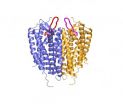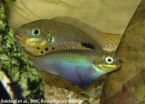The findings are described in the October 7, 2010 issue of the journal Science.
The structure offers a detailed view of how the cell surface receptor, called CXCR4, interacts with molecules outside the cell. The results have implications for developing new drugs for hematopoetic stem cell transplantation, a therapeutic path to treat cancer and immune disorders, as well as for treating HIV infection.
"The structures open up entire new areas for understanding fundamental principles in chemokine GPCR signaling," said Scripps Research Professor Raymond C. Stevens, who is senior author of the collaborative study.
Sniffing Out Signals
CXCR4 belongs to a large family of more than 700 proteins known as G protein-coupled receptors (GPCRs). These proteins sit in the cell membrane and sense various molecules outside the cell, including odors, hormones, neurotransmitters, and light. After binding these molecules, GPCRs trigger the appropriate response inside the cell.
"My lab is really interested in how this one protein family recognizes millions of different types of ligands with incredible specificity," said Stevens, "and how when one ligand binds a receptor it may have one intracellular effect such as activation and a closely related ligand can have an opposite effect such as antagonism."
To understand how these receptors function, the Stevens group has already determined the structures of two other GPCRs: the adrenergic receptor, involved in the fight-or-flight response, and the A2A adenosine receptor, sometimes also referred to as the "caffeine" receptor. The newly solved protein CXCR4 belongs to a different group of GPCRs, one that binds to protein molecules called chemokines, which primarily function to steer the movement of blood and immune cells to their appropriate locations in the body.
Comparing Wine Glasses
To get the first-ever glimpse of a chemokine receptor bound to a ligand, Stevens and colleagues turned to GPCR biochemistry, receptor stabilization and X-ray crystallography.
"One challenging aspect of this research is the biochemistry—learning what the receptor likes and dislikes," said Stevens. "Each receptor and receptor-ligand complex has a distinctly different biophysical personality."
The crystal structure of CXCR4, just like that of other known GPCRs, resembles a wine glass stuck inside the cell membrane, with the glass opening (where the ligands bind) facing the outside of the cell and the stem portion the inside. But there are important differences.
"The adrenergic receptor looks like a pinot noir glass that curves inward towards the top to hold in the wine vapors; the A2A receptor looks like a champagne flute," explained Stevens. "The CXCR4 structure looks like chardonnay glass with a wider opening and shorter depth."
The wider mouth allows CXCR4 to bind to its chemokine ligand, CXCL-12, which is a protein and thus a larger molecule than the ligands that bind the adrenergic and A2Areceptors. CXCL-12 is the signal in the blood that guides hematopoetic stem cells to the bone marrow, a process known as homing.
Finding Therapies
One of the biggest surprises of the CXCR4 structure was that this receptor, unlike the adrenergic and A2A receptors, likes to form pairs or dimers.
"The dimerization observation was very intriguing," said Stevens. "We solved five different crystal structures in multiple crystal forms, and each one had the same dimer interface. It has long been debated how GPCRs might dimerize, if they did at all. This is the first solid observation about a consistent structural GPCR dimer."
Preventing dimerization might provide a new way to block CXCR4 function. Drugs that block CXCR4 appear to be capable of releasing hematopoietic stem cells from the bone marrow into the bloodstream—a step that is critical for stem cell transplantation. Only one such drug, called Mozobil, is currently on the market. In addition, drugs that block CXCR4 are useful in treating HIV infection.
Having determined the structure of CXCR4, Stevens and colleagues were able to determine which portions of the protein are critical to chemokine recognition. This knowledge can now be used to understand basic principles of chemokine recognition and signaling, as well as to design new therapeutic candidates or improve the affinity and efficacy of existing drugs.
Like all membrane proteins, GPCRs are notoriously difficult to crystallize, but CXCR4 was a particularly difficult structure to crack, according to Stevens.
"Each GPCR structure is a tour de force and this one took a team of several people three years to complete," he said. " I wish I could identify one step that was the most challenging, but I would say every step was hard."
Stevens credits the perseverance and creativity of Research Associate Beili Wu, (who was first author of the paper), Scientific Associate Ellen Chien, and Assistant Professor Vadim Cherezov for noteworthy breakthroughs. Stevens also notes that working in close collaboration with colleagues Alexei Brooun, Chris Bi, and Peter Wells at Pfizer La Jolla and Professors Tracy Handel and Ruben Abagyan at the University of California, San Diego (UCSD) led to much of the success where chemistry, biological insight, and structural biology were brought together in a synergistic and productive manner. ###
In addition to Stevens, Wu, Chien, Cherezov, Brooun, Bi, Wells, Handel, and Abagayan, the paper, "Structure of the CXCR4 chemokine receptor with small molecule and cyclic peptide antagonists," was authored by Clifford D. Mol, Gustavo Fenalti, Wei Liu, and Peter Kuhn of Scripps Research, and Vsevolod Katrich and Damon J. Hamel of UCSD.
This work was supported by the National Institutes of Health Protein Structure Initiative, NIH Common Fund, and Pfizer.
About The Scripps Research Institute
The Scripps Research Institute is one of the world's largest independent, non-profit biomedical research organizations, at the forefront of basic biomedical science that seeks to comprehend the most fundamental processes of life. Scripps Research is internationally recognized for its discoveries in immunology, molecular and cellular biology, chemistry, neurosciences, autoimmune, cardiovascular, and infectious diseases, and synthetic vaccine development. An institution that evolved from the Scripps Metabolic Clinic founded by philanthropist Ellen Browning Scripps in 1924, Scripps Research currently employs approximately 3,000 scientists, postdoctoral fellows, scientific and other technicians, doctoral degree graduate students, and administrative and technical support personnel. Headquartered in La Jolla, California, the institute also includes Scripps Florida, whose researchers focus on basic biomedical science, drug discovery, and technology development. Scripps Florida is located in Jupiter, Florida. For more information, see www.scripps.edu
END


